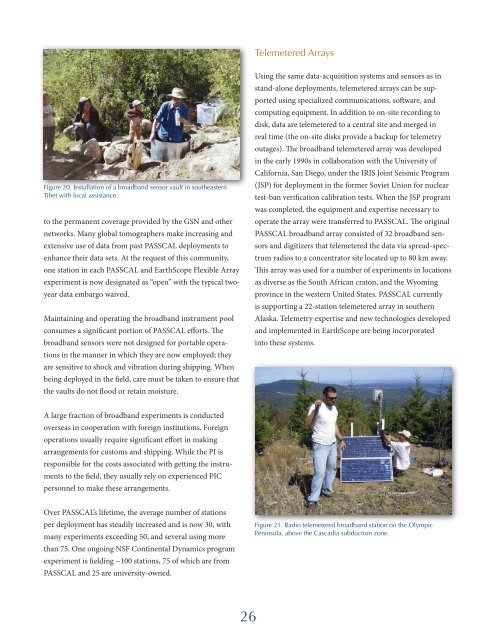Download 9.3 Mb pdf - IRIS
Download 9.3 Mb pdf - IRIS
Download 9.3 Mb pdf - IRIS
Create successful ePaper yourself
Turn your PDF publications into a flip-book with our unique Google optimized e-Paper software.
Telemetered Arrays<br />
Figure 20. Installation of a broadband sensor vault in southeastern<br />
Tibet with local assistance.<br />
to the permanent coverage provided by the GSN and other<br />
networks. Many global tomographers make increasing and<br />
extensive use of data from past PASSCAL deployments to<br />
enhance their data sets. At the request of this community,<br />
one station in each PASSCAL and EarthScope Flexible Array<br />
experiment is now designated as “open” with the typical twoyear<br />
data embargo waived.<br />
Maintaining and operating the broadband instrument pool<br />
consumes a significant portion of PASSCAL efforts. The<br />
broadband sensors were not designed for portable operations<br />
in the manner in which they are now employed; they<br />
are sensitive to shock and vibration during shipping. When<br />
being deployed in the field, care must be taken to ensure that<br />
the vaults do not flood or retain moisture.<br />
Using the same data-acquisition systems and sensors as in<br />
stand-alone deployments, telemetered arrays can be supported<br />
using specialized communications, software, and<br />
computing equipment. In addition to on-site recording to<br />
disk, data are telemetered to a central site and merged in<br />
real time (the on-site disks provide a backup for telemetry<br />
outages). The broadband telemetered array was developed<br />
in the early 1990s in collaboration with the University of<br />
California, San Diego, under the <strong>IRIS</strong> Joint Seismic Program<br />
(JSP) for deployment in the former Soviet Union for nuclear<br />
test-ban verification calibration tests. When the JSP program<br />
was completed, the equipment and expertise necessary to<br />
operate the array were transferred to PASSCAL. The original<br />
PASSCAL broadband array consisted of 32 broadband sensors<br />
and digitizers that telemetered the data via spread-spectrum<br />
radios to a concentrator site located up to 80 km away.<br />
This array was used for a number of experiments in locations<br />
as diverse as the South African craton, and the Wyoming<br />
province in the western United States. PASSCAL currently<br />
is supporting a 22-station telemetered array in southern<br />
Alaska. Telemetry expertise and new technologies developed<br />
and implemented in EarthScope are being incorporated<br />
into these systems.<br />
A large fraction of broadband experiments is conducted<br />
overseas in cooperation with foreign institutions. Foreign<br />
operations usually require significant effort in making<br />
arrangements for customs and shipping. While the PI is<br />
responsible for the costs associated with getting the instruments<br />
to the field, they usually rely on experienced PIC<br />
personnel to make these arrangements.<br />
Over PASSCAL’s lifetime, the average number of stations<br />
per deployment has steadily increased and is now 30, with<br />
many experiments exceeding 50, and several using more<br />
than 75. One ongoing NSF Continental Dynamics program<br />
experiment is fielding ~100 stations, 75 of which are from<br />
PASSCAL and 25 are university-owned.<br />
Figure 21. Radio telemetered broadband station on the Olympic<br />
Peninsula, above the Cascadia subduction zone.<br />
26

















